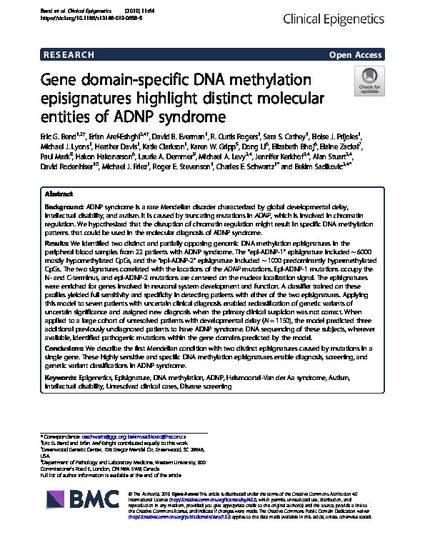
BACKGROUND:
ADNP syndrome is a rare Mendelian disorder characterized by global developmental delay, intellectual disability, and autism. It is caused by truncating mutations in ADNP, which is involved in chromatin regulation. We hypothesized that the disruption of chromatin regulation might result in specific DNA methylation patterns that could be used in the molecular diagnosis of ADNP syndrome.
RESULTS:
We identified two distinct and partially opposing genomic DNA methylation episignatures in the peripheral blood samples from 22 patients with ADNP syndrome. The "epi-ADNP-1" episignature included ~ 6000 mostly hypomethylated CpGs, and the "epi-ADNP-2" episignature included ~ 1000 predominantly hypermethylated CpGs. The two signatures correlated with the locations of the ADNP mutations. Epi-ADNP-1 mutations occupy the N- and C-terminus, and epi-ADNP-2 mutations are centered on the nuclear localization signal. The episignatures were enriched for genes involved in neuronal system development and function. A classifier trained on these profiles yielded full sensitivity and specificity in detecting patients with either of the two episignatures. Applying this model to seven patients with uncertain clinical diagnosis enabled reclassification of genetic variants of uncertain significance and assigned new diagnosis when the primary clinical suspicion was not correct. When applied to a large cohort of unresolved patients with developmental delay (N = 1150), the model predicted three additional previously undiagnosed patients to have ADNP syndrome. DNA sequencing of these subjects, wherever available, identified pathogenic mutations within the gene domains predicted by the model.
CONCLUSIONS:
We describe the first Mendelian condition with two distinct episignatures caused by mutations in a single gene. These highly sensitive and specific DNA methylation episignatures enable diagnosis, screening, and genetic variant classifications in ADNP syndrome.
Available at: http://works.bepress.com/bekim-sadikovic/21/

Also available open access in Clinical Epigenetics at: https://doi.org/10.1186/s13148-019-0658-5